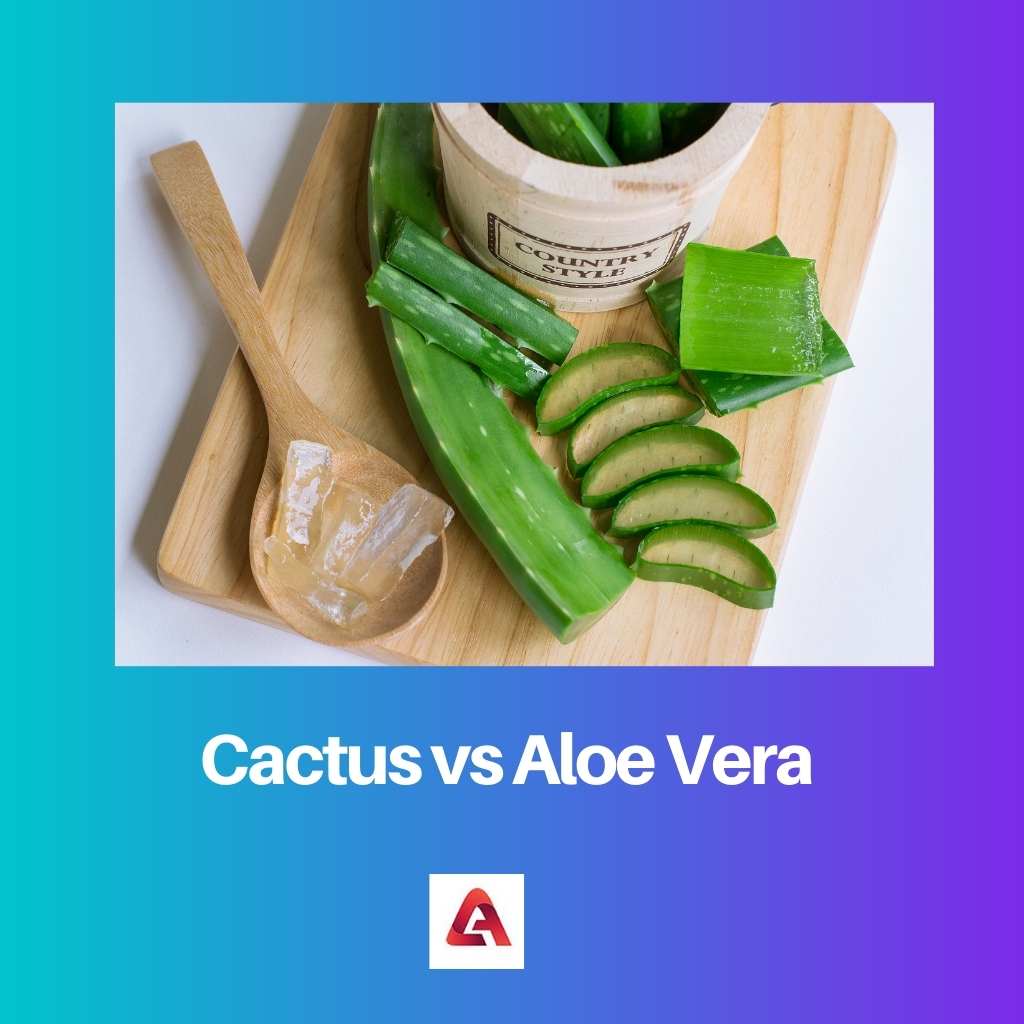Succulents are drought-resistant plants that have the special feature of storing water in the plant. Succulents have characteristic features of fleshy thick stems and leaves and are found in dry environments.
The two most common succulents which seem similar are Cactus and Aloe Vera. Both the succulents have distinct differences from each other.
Key Takeaways
- Cacti are spiny succulents, while aloe vera is a non-spiny succulents.
- Cacti store water in their stem, whereas aloe vera stores water in their leaves.
- Cactus plants are native to the Americas, while aloe vera is indigenous to the Arabian Peninsula.
Cactus vs Aloe Vera
The difference between cactus and aloe vera is that cactus does not have any leaves as the leaves are modified into thorns and spines. On the other hand, Aloe Vera contains leaves. Cactus is not a medicinal plant while Aloe Vera is a medicinal plant.

Cactus have various shapes and sizes and are primarily seen in a rounded shape. The succulent can grow wildly in desert climates. The plant can tolerate extreme heat and warm climates.
The core of the cactus is very strong. The water storage system in the plant is mainly in its stems.
While Aloe Vera has elongated leaves and does not grow round. The plant grows wildly in rock mountains tropical forests and even in the outskirts of the rainforests.
The plant cannot tolerate extreme heat or sunlight. The water storage system in the plant is mainly in its leaves.
Comparison Table
| Parameters of Comparison | Cactus | Aloe Vera |
|---|---|---|
| Origin | Native plant of America | Arabian Peninsula |
| Order of the plant | Caryophyllales | Asparagales |
| Family of the plant | Cactaceae | Asphodelaceae |
| Subfamily of the plant | Cactoideae, Opuntioideae, Maihuenioideae and Pereskioideae | Asphodeloideae |
| Genus | Pereskia | Aloe |
What is Cactus?
Cactus belongs to the family of Cactaceae. The plant is also known as cacti or cactuses. The order of the family of Cactus is Caryophyllales.
The derivation of the term cactus is from the Ancient Greek word “káktos” through Latin. The plant can occur in a diverse range of sizes and shapes.
The plant can survive not only in humid environments but also in drought conditions.
The adaptation of the cactus is to conserve water. The plant is succulent and hence has fleshy thick parts which can store water. In the cactus, the stem performs the task of storing water.
The plant does not have true leaves. Instead, the leaves have been modified into spines, to reduce the rate of water loss from the plant. These spines also defend the plant against herbivores.
The production of spines in the cactus is from structures known as areoles. These specialized structures can produce flowers as it is multi-petaled and tubular type.
Cactus plans have a long dormancy period and a short growing season. The reaction of the plant to rainfall is quick as the root system is shallow.
The stems of the plant are fluted or ribbed which helps in quick contraction and expansion for water absorption.
Cactus is a native plant of America. The tallest cactus in the world which is freestanding is Pachycereus pringlei with a height of 63 ft.
The subfamilies of the plant are Cactoideae, Opuntioideae, Maihuenioideae, and Pereskioideae.
Photosynthesis in the succulent is carried out through a special mechanism known as CAM (Crassulacean Acid Metabolism).

What is Aloe Vera?
Aloe Vera is an evergreen perennial plant that belongs to the family of Asphodelaceae. It is a succulent species of plant. The genus of the plant is Aloe and the subfamily is Asphodeloideae.
The origin of the plant is from Arabian Peninsula. The plant can grow wildly in arid climates and tropical and semi-tropical areas.
The cultivation of the plant is also done for commercial purposes. It is used in products like cosmetics, skin lotions, ointments, beverages, or as a gel for sunburns, moisturizers, or minor burns.
The juice of the plant is also consumed as it has various health benefits. The succulent is an attractive decorative indoor potted plant.
Some common names of the plant are Barbados aloe, Chinese aloe, and even Cape aloe.
Aloe Vera has very short stems and even no stems at times. The spread of the plant is through offsets. The succulent has thick fleshy grey or green leaves.
Some varieties of the plant have white flecks on the surface of the plant. The leaf of the plant has a margin that is serrated and even contains small white teeth.
Aloe Vera produces flowers in the summer season which are pendulous, tubular, corolla, and yellow.
Aloe Vera has a symbiosis process known as arbuscular mycorrhiza which helps the plant in accessing the minerals and nutrients present in the soil.
The plant has various phytochemicals present for bioactivities like anthraquinone C- glycosides, acetylated mannans, anthrones, polymannans, lectins, and other anthraquinones.

Main Differences Between Cactus and Aloe Vera
- The leaves of the cactus plant are the spikes while Aloe Vera has special spikes on the ridges of its leaves.
- Cactus has stems that contain the fleshy part while Aloe Vera does not have any stem or may have very short stems at times.
- Cactus can grow in tall heights while Aloe Vera remains close to the ground and cannot grow tall.
- The Cactus plant has nourishing properties while the Aloe Vera plant has healing properties.
- Cactus grows well in a hot and dry place while Aloe Vera grows well in a tropical environment.

- https://www.sciencedirect.com/science/article/pii/S0009261417304232
- https://www.sciencedirect.com/science/article/pii/S0144861717307038
